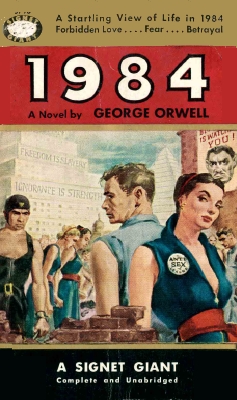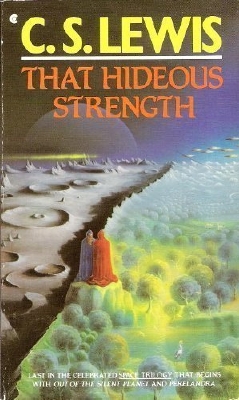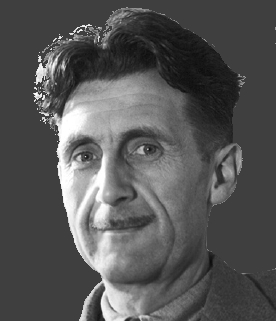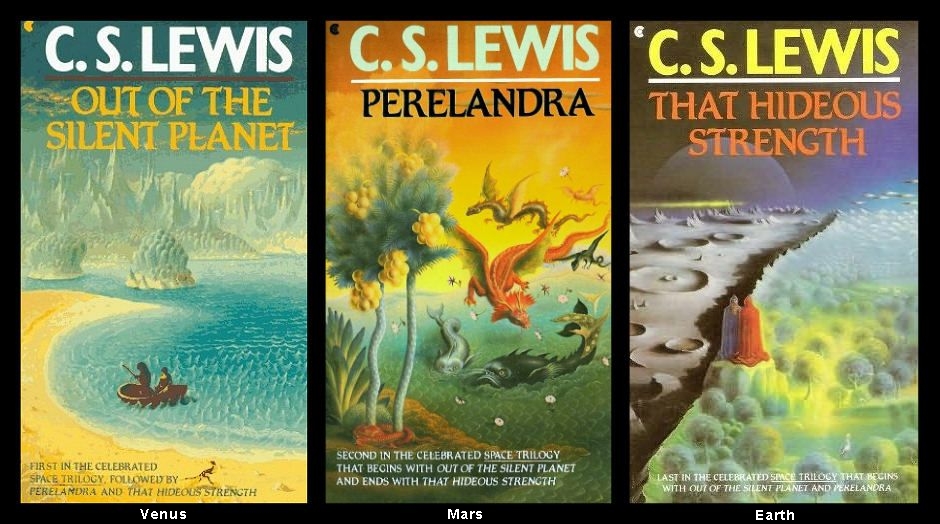
Preface; A comparison of the commonalities, similarities and differences between the Classic ‘1984 by George Orwell’, and the lesser known, ‘That Hideous Strength’, part of C.S. Lewis’ Space Trilogy.
Between the three years that separated their publishing the world learned of the Atomic Bomb and effected each conclusion. Still it is amazing how messers Lewis & Orwell foresaw our reality today. More can be found in a lively YouTube discussion between Walter Kern and Matt Taibbi here. - W. W.


Overview of the Books and Their Contexts
C.S. Lewis's That Hideous Strength (1945), the final installment in his Space Trilogy, is a dystopian novel blending science fiction, fantasy, and Christian allegory. It follows a young academic couple drawn into a conflict between a sinister scientific institute called the National Institute of Coordinated Experiments (N.I.C.E.)—which seeks to reshape humanity through technocratic control—and a small group of resistors aided by supernatural forces. George Orwell's 1984 (1949) is a stark political dystopia depicting a totalitarian superstate called Oceania, where the ruling Party enforces constant surveillance, truth manipulation, and psychological control under the figurehead Big Brother.
Both novels were shaped by the authors' experiences in the mid-20th century, amid World War II's horrors, rising totalitarianism (e.g., Nazism and Stalinism), and rapid scientific advancements. Lewis completed That Hideous Strength during the war, with publication coinciding roughly with the end of hostilities in Europe (May 1945) and just before the atomic bombings of Hiroshima and Nagasaki (August 1945). Orwell, recovering from illness and influenced by postwar realities, wrote 1984 between 1946 and 1948. This places Lewis's work in a pre-atomic bomb era of uncertainty and wartime fears, while Orwell's reflects a post-atomic bomb world grappling with nuclear escalation and the emerging Cold War.
Commonalities and Similarities
Both novels share profound thematic overlaps as critiques of authoritarianism, drawing from the authors' shared era of global conflict and ideological extremism. They emerged from a world scarred by WWII, where totalitarian regimes demonstrated the perils of unchecked power, propaganda, and dehumanization.
- Warnings Against Totalitarianism and Power Structures: Lewis and Orwell portray dystopian societies dominated by opaque, bureaucratic organizations that erode individual freedom. In That Hideous Strength, N.I.C.E. masquerades as a progressive scientific body but pursues godlike control over life and society, echoing real-world fears of eugenics and state-sponsored experiments during WWII. Similarly, 1984's Party maintains power through endless war, surveillance (e.g., telescreens), and the rewriting of history. Both highlight how elites use euphemistic language to mask evil—N.I.C.E. as a "coordinated" institute, akin to Orwell's Ministries of Truth, Peace, Love, and Plenty, which embody their opposites. These reflect the authors' observations of wartime propaganda and totalitarian states like Nazi Germany and Soviet Russia, where truth was subordinated to ideology.
- Critique of Scientism and Technology's Misuse: The novels caution against science divorced from ethics, a concern amplified by WWII's technological warfare (e.g., rockets, chemical weapons). Lewis depicts N.I.C.E. as pursuing immortality and human engineering through vivisection and mind control, symbolizing "hideous strength" as humanity's hubristic overreach. Orwell shows technology enabling omnipresent monitoring and brainwashing, with inventions like the telescreen enforcing conformity. Both authors, as "outsiders" to the establishment, feared science becoming a tool for domination rather than progress.
- Media Manipulation and Narrative Control: In both, regimes control information to shape reality. N.I.C.E. orchestrates press campaigns to incite riots and justify their agenda, mirroring 1984's Ministry of Truth, where history is falsified daily. This draws from WWII's censorship and propaganda machines, where both authors witnessed how media could distort public perception.
- Prophetic Insights into Modern Society: Written in the 1940s, both anticipate elements of later 20th-century issues, such as surveillance states, ideological conformity, and the erosion of privacy. Analyses often note their relevance to contemporary "progressivism" or authoritarianism, with Lewis's work seen as equally prescient as Orwell's in depicting sensual manipulation or bureaucratic overreach.
In relation to their worlds, these commonalities stem from a shared pre- and immediate postwar anxiety: the fragility of civilization amid global war. Lewis and Orwell both drew from the era's existential threats, but Lewis's pre-atomic perspective focuses on moral and spiritual decay, while Orwell's post-atomic lens incorporates nuclear devastation as a catalyst for eternal stalemate.

Differences
Despite thematic alignments, the novels diverge in tone, worldview, and narrative style, influenced by the authors' philosophies and the shifting historical moment from wartime to nuclear-age fears.
- Secular vs. Supernatural Frameworks: Orwell's 1984 is grounded in atheistic realism, portraying a hopeless, mechanistic world where power is an end in itself ("If you want a picture of the future, imagine a boot stamping on a human face—forever"). Evil is human-made, with no redemption. Lewis, a Christian apologist, infuses That Hideous Strength with mythological and biblical elements—angels (oyéresu), Merlin's revival, and divine intervention—framing the conflict as a cosmic battle between good and evil. The resolution involves supernatural judgment, contrasting 1984's bleak defeat of the protagonist. This reflects Lewis's pre-atomic optimism in ultimate moral order versus Orwell's post-atomic despair.
- Approach to Sensuality and Control: Lewis shows N.I.C.E. promoting hedonism and sensuality to degrade humanity, aligning with his critique of moral relativism in wartime society. Orwell depicts sensuality as suppressed (e.g., the Anti-Sex League), emphasizing ascetic control to channel energy into loyalty. This difference highlights Lewis's focus on spiritual corruption versus Orwell's on psychological domination.
- Narrative Scope and Style: That Hideous Strength blends genres—dystopia with fantasy, romance, and satire—spanning cosmic scales. 1984 is tightly focused on political psychology, with a more straightforward, oppressive prose. Lewis's work feels allegorical and hopeful; Orwell's is unrelentingly grim. Orwell himself reviewed That Hideous Strength critically in 1945, praising its satire but criticizing its "preposterous" fantastical elements and perceived reactionary undertones.
- Protagonists and Resolution: Lewis's heroes (e.g., Jane and Mark Studdock) find redemption through community and faith, with evil overthrown dramatically. Orwell's Winston Smith is broken irreparably, loving Big Brother in defeat. This underscores Lewis's pre-atomic belief in resistance's potential versus Orwell's post-atomic fatalism.
Relation to Pre-Atomic vs. Post-Atomic Worlds
The atomic bomb serves as a pivotal divide, influencing how each author extrapolates dystopian fears from their era.
- Lewis's Pre-Atomic Perspective (WWII Era): Written amid the Blitz and wartime rationing, That Hideous Strength reflects anxieties about conventional warfare, scientific hubris (e.g., Nazi experiments), and moral decline without direct nuclear references. However, its themes of "hideous strength"—destructive technologies and forbidden knowledge—parallel the bomb's emergence. Some interpretations link it to Lewis's broader concerns with ultimate weapons, akin to the "Deplorable Word" in his Narnia series, symbolizing irreversible destruction. The novel's publication just before Hiroshima underscores a world on the cusp, where science's perils were imagined but not yet nuclear-scaled.
- Orwell's Post-Atomic Perspective (Early Cold War): The bomb profoundly shaped 1984, as Orwell wrote shortly after Hiroshima. In his 1945 essay "You and the Atom Bomb," he predicted nuclear weapons would perpetuate oligarchic stalemates, preventing revolutions by making conquest impossible. This manifests in 1984's backstory: atomic wars in the 1950s-1960s devastate the world, leading to the superstates' perpetual conflict. Rocket bombs and nuclear references evoke V-2 rockets and Hiroshima, symbolizing technology's role in eternal tyranny. The post-bomb world amplified Orwell's pessimism, viewing nukes as tools that "rob the exploited classes... of all power to revolt."
In summary, while both novels critique similar societal ills rooted in WWII, the atomic bomb marks a shift: Lewis's pre-bomb world allows for supernatural hope amid destruction, whereas Orwell's post-bomb reality envisions inescapable, nuclear-fueled despair. Their enduring relevance lies in how these visions, born of their times, continue to mirror ongoing debates about power, technology, and freedom.
C.S. LEWIS SPACE TRILIGY
Love to see this series made into a movie

Summary of C.S. Lewis’s Space Trilogy (Out of the Silent Planet, Perelandra, and That Hideous Strength) is a science fiction series infused with Christian themes, exploring humanity’s place in the cosmos, the nature of good and evil, and the struggle between divine will and human ambition. Below is a combined synopsis of the three books:
The trilogy follows Dr. Elwin Ransom, a Cambridge philologist, as he journeys through the solar system and confronts cosmic forces of good and evil. In Out of the Silent Planet, Ransom is kidnapped by scientists Devine and Weston and taken to Malacandra (Mars), where he discovers a harmonious, unfallen world inhabited by diverse, intelligent creatures living under the guidance of angelic beings called eldila, led by the Oyarsa of Malacandra. Escaping his captors, Ransom learns of humanity’s fallen nature and the silent planet, Earth, isolated due to its corruption.
In Perelandra, Ransom is summoned by the eldila to Venus (Perelandra), a vibrant, Edenic world where a new Adam and Eve, the Green Lady and her King, face temptation. Weston, now possessed by a demonic force, attempts to corrupt the Green Lady, mirroring Satan’s role in Eden. Ransom, guided by divine purpose, physically and philosophically battles Weston to preserve Perelandra’s innocence, exploring free will, obedience, and the beauty of an unfallen creation.
That Hideous Strength shifts to Earth, where a sinister organization, the N.I.C.E., seeks to dominate humanity through science, technology, and occult forces, aiming to eradicate free will and merge man with machine. Ransom, now the Pendragon and leader of a small resistance, allies with a group of faithful individuals, including Jane and Mark Studdock, to oppose the N.I.C.E.’s dystopian agenda. With the intervention of heavenly powers, including Merlin and the Oyarsa of other planets, the battle becomes a cosmic struggle between divine order and human hubris.
Together, the trilogy weaves a narrative of cosmic redemption, contrasting unfallen worlds with Earth’s corruption, and emphasizing themes of obedience, free will, and the eternal conflict between good and evil, culminating in a defense of humanity’s spiritual purpose against dehumanizing forces.